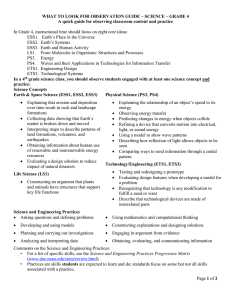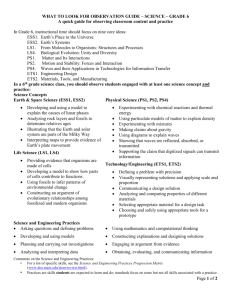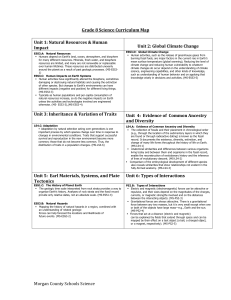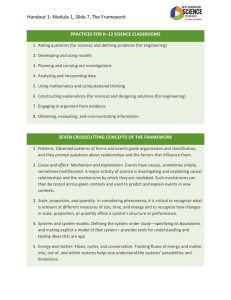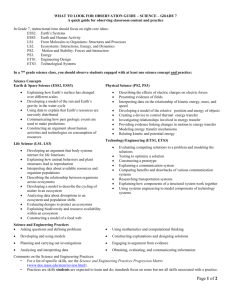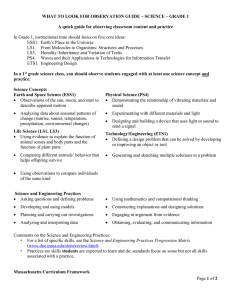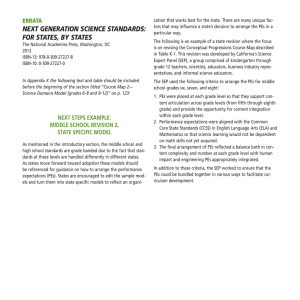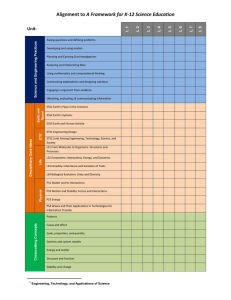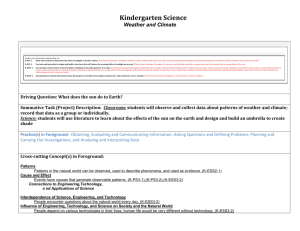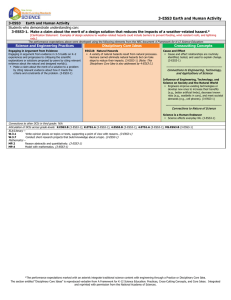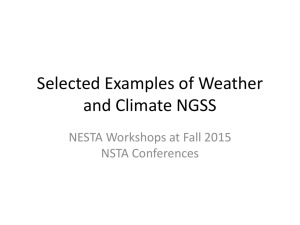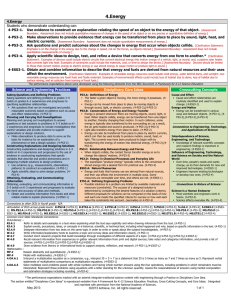Year Long Plan | 32.8KB
advertisement
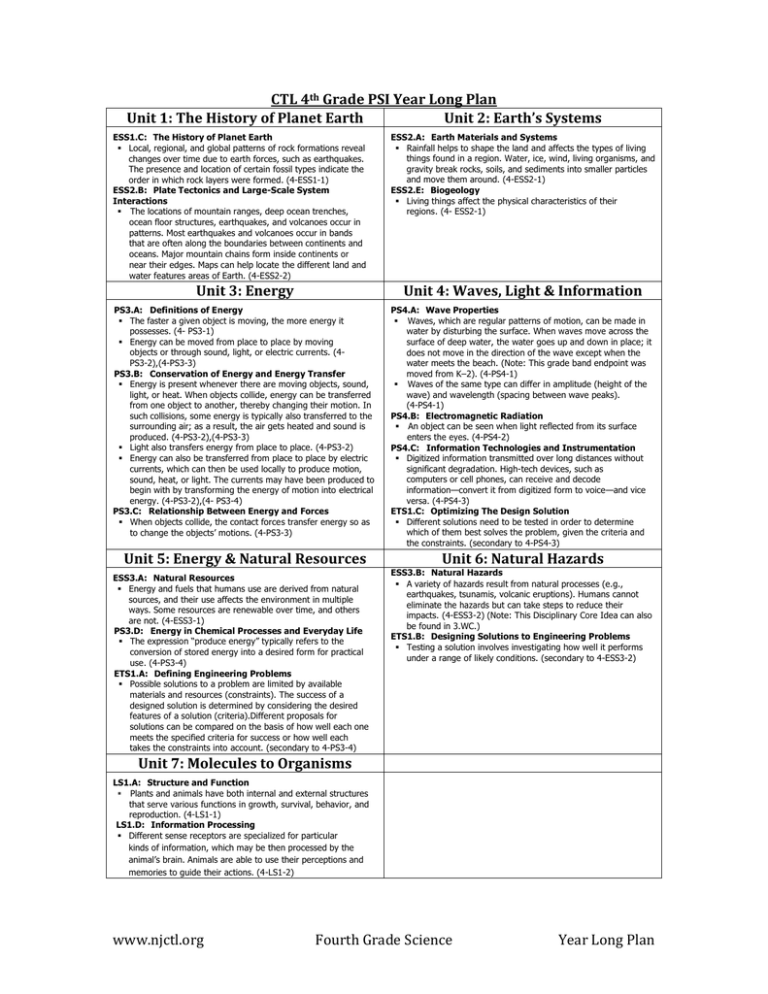
CTL 4th Grade PSI Year Long Plan Unit 1: The History of Planet Earth Unit 2: Earth’s Systems ESS1.C: The History of Planet Earth Local, regional, and global patterns of rock formations reveal changes over time due to earth forces, such as earthquakes. The presence and location of certain fossil types indicate the order in which rock layers were formed. (4-ESS1-1) ESS2.B: Plate Tectonics and Large-Scale System Interactions The locations of mountain ranges, deep ocean trenches, ocean floor structures, earthquakes, and volcanoes occur in patterns. Most earthquakes and volcanoes occur in bands that are often along the boundaries between continents and oceans. Major mountain chains form inside continents or near their edges. Maps can help locate the different land and water features areas of Earth. (4-ESS2-2) ESS2.A: Earth Materials and Systems Rainfall helps to shape the land and affects the types of living things found in a region. Water, ice, wind, living organisms, and gravity break rocks, soils, and sediments into smaller particles and move them around. (4-ESS2-1) ESS2.E: Biogeology Living things affect the physical characteristics of their regions. (4- ESS2-1) Unit 3: Energy Unit 4: Waves, Light & Information PS3.A: Definitions of Energy The faster a given object is moving, the more energy it possesses. (4- PS3-1) Energy can be moved from place to place by moving objects or through sound, light, or electric currents. (4PS3-2),(4-PS3-3) PS3.B: Conservation of Energy and Energy Transfer Energy is present whenever there are moving objects, sound, light, or heat. When objects collide, energy can be transferred from one object to another, thereby changing their motion. In such collisions, some energy is typically also transferred to the surrounding air; as a result, the air gets heated and sound is produced. (4-PS3-2),(4-PS3-3) Light also transfers energy from place to place. (4-PS3-2) Energy can also be transferred from place to place by electric currents, which can then be used locally to produce motion, sound, heat, or light. The currents may have been produced to begin with by transforming the energy of motion into electrical energy. (4-PS3-2),(4- PS3-4) PS3.C: Relationship Between Energy and Forces When objects collide, the contact forces transfer energy so as to change the objects’ motions. (4-PS3-3) PS4.A: Wave Properties Waves, which are regular patterns of motion, can be made in water by disturbing the surface. When waves move across the surface of deep water, the water goes up and down in place; it does not move in the direction of the wave except when the water meets the beach. (Note: This grade band endpoint was moved from K–2). (4-PS4-1) Waves of the same type can differ in amplitude (height of the wave) and wavelength (spacing between wave peaks). (4-PS4-1) PS4.B: Electromagnetic Radiation An object can be seen when light reflected from its surface enters the eyes. (4-PS4-2) PS4.C: Information Technologies and Instrumentation Digitized information transmitted over long distances without significant degradation. High-tech devices, such as computers or cell phones, can receive and decode information—convert it from digitized form to voice—and vice versa. (4-PS4-3) ETS1.C: Optimizing The Design Solution Different solutions need to be tested in order to determine which of them best solves the problem, given the criteria and the constraints. (secondary to 4-PS4-3) Unit 5: Energy & Natural Resources ESS3.A: Natural Resources Energy and fuels that humans use are derived from natural sources, and their use affects the environment in multiple ways. Some resources are renewable over time, and others are not. (4-ESS3-1) PS3.D: Energy in Chemical Processes and Everyday Life The expression “produce energy” typically refers to the conversion of stored energy into a desired form for practical use. (4-PS3-4) ETS1.A: Defining Engineering Problems Possible solutions to a problem are limited by available materials and resources (constraints). The success of a designed solution is determined by considering the desired features of a solution (criteria).Different proposals for solutions can be compared on the basis of how well each one meets the specified criteria for success or how well each takes the constraints into account. (secondary to 4-PS3-4) Unit 6: Natural Hazards ESS3.B: Natural Hazards A variety of hazards result from natural processes (e.g., earthquakes, tsunamis, volcanic eruptions). Humans cannot eliminate the hazards but can take steps to reduce their impacts. (4-ESS3-2) (Note: This Disciplinary Core Idea can also be found in 3.WC.) ETS1.B: Designing Solutions to Engineering Problems Testing a solution involves investigating how well it performs under a range of likely conditions. (secondary to 4-ESS3-2) Unit 7: Molecules to Organisms LS1.A: Structure and Function Plants and animals have both internal and external structures that serve various functions in growth, survival, behavior, and reproduction. (4-LS1-1) LS1.D: Information Processing Different sense receptors are specialized for particular kinds of information, which may be then processed by the animal’s brain. Animals are able to use their perceptions and memories to guide their actions. (4-LS1-2) www.njctl.org Fourth Grade Science Year Long Plan
